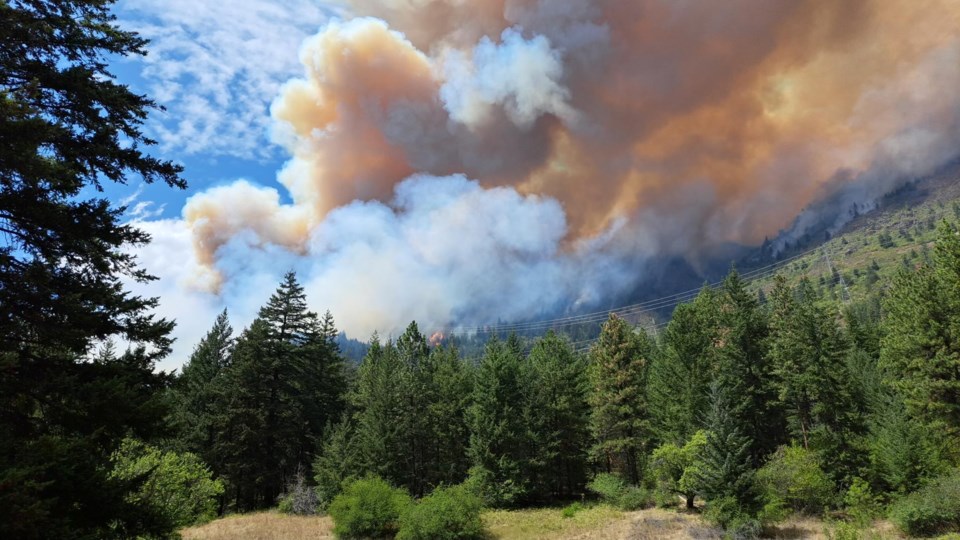The Squamish-Lillooet Regional District (SLRD) is pushing for greater provincial support for communities to plan for, and recover from, disasters like this summer’s wildfires that in remote areas north of Pemberton and west of Lillooet, in what was British Columbia’s worst fire season on record.
In a report last month on the state of the SLRD’s staff in the aftermath of the local fires, interim CAO Nikki Gilmore said it had taken a huge commitment of time and resources, with efforts to recover still ongoing and cutting into other SLRD programs.
“The reality is a lot of those initiatives weren’t able to be put forward because [the fires were ongoing] for 11 weeks. That’s a significant amount of time, and at this point staff are tired,” she said at the Oct. 25 SLRD board meeting. “It’s not that anyone’s not wanting to proceed with these projects, they just don’t have time.”
The SLRD’s Area A—covering 3,715 square kilometres in the Upper Bridge River Valley and home to 305 people—was the worst hit, with 56 properties impacted by the fires, of which 51 were a total loss. Many of the properties were built decades ago, with different building and environmental requirements. Their destruction, and the subsequent need for clean-up, means there are logistical and jurisdictional snafus for property owners and the SLRD.
Gilmore said the SLRD had maintained efforts beyond the Emergency Operations Centre (EOC) to provide residents with information they needed for the recovery, noting that clean-up of properties, water-quality testing (due to runoff into lakes used for water supply), and environmental concerns were sticking points for residents that had remediation responsibilities beyond their capabilities.
With so many properties affected, Gilmore said efforts to expand services to meet residents’ needs and obligations had run into problems.
“We asked [the province] for $220,000 to expand hours and bins at the Gold Bridge transfer station and Lillooet landfill, and we were denied that,” she explained, adding the SLRD has been challenging the province on that due to the capacity needed to adequately carry out clean-up, which is estimated at 4,000 tonnes of debris.
The SLRD inquired about financial assistance for property owners in the recovery, but heard from the province that the fires were “an insurable event” and, as such, the affected properties should have been insured.
“Coulda, woulda, shoulda. The reality is individuals need a little bit of assistance,” Gilmore said, adding SLRD staff was trying to line up more resources for locals in the meantime.
However, Gilmore also said the SLRD does need to set some expectations, noting eventually they would run out of financial streams for help because the province was directing resources elsewhere, and responsibility would fall to landowners.
“The public expectation needs to be measured against the fact that this is the and there are [other] communities that have suffered as well,” said SLRD board chair Jen Ford.
“When the province is looking at how they allocate time and resources, they are going to do it based on a number of criteria … Where we fall into that needs to be taken seriously when we hear from residents. It’s not that there isn’t a desire to help them, but there’s a triage in place.”
Director Jenna Stoner said recovery from disasters is an area governments have not done an adequate job planning for.
“I think this is going to come to the forefront more and more, especially after this wildfire season,” she said, adding would further expose the gap in readiness.
Stoner questioned whether regional districts like the SLRD, which had rural and remote areas disproportionately affected by wildfires, were capable of stepping up given the resources available.
“‘It seems impossible,” she said. “We have a hard enough time managing the EOCs, and realistically our EOC staff managing recovery should be preparing for the next wildfire season and they’re already exhausted and they need a break.”
Stoner suggested the SLRD consider pushing for more centralized, regional recovery support, “so we don’t have to recreate this effort over and over again,” especially considering other communities were experiencing many of the same logistical headaches.
Director Laurie Hopfl agreed, saying local governments needed more from the province, and suggested the SLRD collaborate with other local governments in their push for support.
“If I look at Lytton, they’re at two-plus years, and the recovery… a lot of it has not even started. I think we really need to look at that. We can’t wait two years,” she said. “We need something proactive and we need it now … We wait another year and we’re back into the forest fire season.”
The SLRD board voted unanimously to write a letter to UBCM lobbying for more action from the province on assisting communities in recovery planning and resources.




